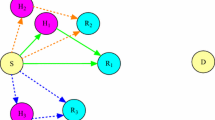Abstract
Cooperative diversity techniques have received a lot of attention recently due to their ability to provide spatial diversity in fading wireless environment without the requirement of implementing multiple antenna on the same device. It increases link reliability, provides higher capacity, reduces transmit power, and extends transmission range for the same level of performance and modulation rate. In this paper, we study the achievable gain of cooperative communications from a wireless cross-layer point of view in multi hop networks. We propose two routing algorithms applicable for wireless ad hoc networks. First, we propose an edge node based on a greedy cooperative routing (ENBGCR) algorithm, where we modify the geographic routing algorithm to incorporate the cooperative transmission and extend the coverage range of the nodes. The main objective of ENBGCR algorithm is to minimize the number of hops that messages transverse to reach their destination. Then the energy-efficient cooperative routing algorithm is proposed to minimize the end-to-end total transmission power subject to end-to-end target data rate. Simulation results for both algorithms show that the proposed strategies have great improvement in terms of delay and power saving respectively for the same quality of service requirement as compared to traditional algorithms.

















Similar content being viewed by others
Notes
For the ENBGCR routing protocol, all nodes are adjusted to transmit with the same power level P.
References
Cover, T., Gammel, A. (1979). Capacity theorems for the relay channel. IEEE Transactions on Computers, 22, 572–584.
Laneman, J., Wornell, G., Tse, D. (2004). Cooperative diversity in wireless networks: Efficient protocols and outage behavior. IEEE Transactions on Information Theory, 50, 3062–3080.
Laneman, J., Wornell, G. (2003). Distributed space-time-coded protocols for exploiting cooperative diversity in wireless networks. IEEE Transactions on Information Theory, 49, 2415–2425.
Sendonaris, A., Erkip, E., Aazhang, B. (2003). User cooperation diversity part I: System description. IEEE Transactions on Computers, 51, 1927–1938.
Sendonaris, A., Erkip, E., Aazhang, B. (2003). User cooperation diversity—part II: Implementation aspects and performance analysis. IEEE Transactions on Computers, 51, 1939–1948.
Hunter, T. E., Nosratinia, A. (2002). Cooperative diversity through coding. IEEE International Symposium on Information Theory (ISIT),220.
Khandani, A., Abounadi, J., Modiano, E., Zheng, L., (2003). Cooperative routing in wireless networks. in Proceedings of Allerton Conference on Communication, Control and Computing.
Li, F., Wu, K., Lippman, A. (2006). Energy-efficient cooperative routing in multi-hop wireless ad hoc networks. Proceedings IEEE International Performance, Computing, and Communications Conference, 215–222.
Fang, X., Hui, T., Ping, Z., Ning, Y. (2005). Cooperative routing strategies in Ad Hoc networks. In Proceedings IEEE Vehicular Technology Conference (VTC), 4, 2509–2512.
Ibrahim, A., Han, Z .(2008). Distributed energy-efficient cooperative routing in wireless networks. IEEE Transactions on Computers, 7, 369–378.
Pandana, C., Siriwongpairat, W., Himsoon, T., Liu, K. (2007). Distributed cooperative routing algorithms for maximizing network lifetime. IEEE Wireless Communications and Networking Conference (WCNC),451–456.
Gui, B., Dai, L., Cimini, L. (2007) Routing strategies in multihop cooperative networks. IEEE Wireless Communications and Networking Conference (WCNC).
Zhang, L., Cimini, L. (2008). Hop-by-hop routing strategy for mul-tihop decode-and-forward cooperative networks. IEEE Wireless Communications and Networking Conference (WCNC).
Ong, L., Motani, M. (2007). Optimal routing for decode-and-forward based cooperation in wireless networks. Proceedings of SECON.
Beres, E., Adve, R. (2007) Cooperation and routing in multi-hop networks, in IEEE International Conference on Communications (ICC), (Glasgow, Scotland), 4767–4772.
Ding, Z., Leung, K. (2011). Cross-layer routing using cooperative transmission in vehicular Ad-hoc networks. IEEE Journal on Selected Areas in Communications, 29, 571–581.
Li, P., Guo, S., Yuy, S., Vasilakos, A.V. (2012) CodePipe: An opportunistic feeding and routing protocol for reliable multicast with pipelined network coding. Procedings IEEE INFOCOM, 100–108.
Wang, Z., Chen, Y., Li, C. (2012). CORMAN: A novel cooperative opportunistic routing scheme in mobile Ad Hoc networks. IEEE Journal on Selected Areas in Communications, 30, 289–296.
Biswas, S., Morris, R. (2005).ExOR: Opportunistic multi-hop routing for wireless networks. in Proceedings ACM Conference of the Special Interest Group on Data Communication (SIGCOMM), 133–144.
He, X., Li, F. Y. (2012) Metric-based cooperative routing in multihop Ad Hoc networks. Journal of Computer Networks and Communications. doi:10.1155/2012/893867.
Liu, K., Sadek, A., Su, W., Kwasinski, A. (2009). Cooperative communications and networking (2nd ed.). Cambridge: Cambridge University Press.
Mauve, M., Widmer, J., Hartenstein, H. (2001). A survey on position based routing in ad-hoc networks. IEEE Network Magnization, 15, 30–39.
Stojmenovic, I., tin, X. (2001). Looop-free hybrid single path/flooding routing algorithms with guoronteed delivery for wireless networks. IEEE Transactions on Parrallel and Distributed Systems, 12, 1023–1032.
Takagi, H., Kleinrock, L. (1984). Optimal transmission ranges for randomly distributed packet radio terminals. IEEE Transactions on Computers, 32, 246–257.
Gui, B., Dai, L., Cimini, L. (2009). Routing strategies in multihop cooperative networks. IEEE Transactions on Wireless Communication, 8, 843–855.
Heinzelman, W. R., Chandrakasan, A., Balakrishnan, H. (2000) Energy-efficient communication protocol for wireless microsensor networks. Proceedings of the 33rd Hawaii International Conference on System Sciences.
Bertsekas, D., Gallager, R. (1991). Data networks (2nd ed.). Upper Saddle River: Prentice Hall.
Author information
Authors and Affiliations
Corresponding author
Rights and permissions
About this article
Cite this article
Abdulhadi, S., Jaseemuddin, M. & Anpalagan, A. Multi-hop routing with cooperative transmission: a cross-layer approach. Wireless Netw 20, 1685–1697 (2014). https://doi.org/10.1007/s11276-014-0703-4
Published:
Issue Date:
DOI: https://doi.org/10.1007/s11276-014-0703-4




